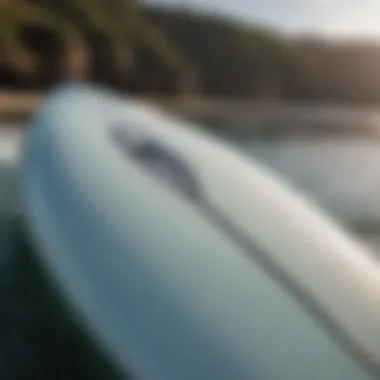Exploring the Innovative World of Motor Surf Boards


Intro
The world of surfing is no longer constrained to the rhythm of ocean waves and the skillful navigation of a traditional surfboard. As technology screeches forward like a rogue wave, motor surf boards have carved out a remarkable niche that blurs the line between sport and innovation. This transformative equipment is more than just a surfboard with a twist; it's a whole new approach to experiencing our beloved waters.
Embracing motorized power, these boards have surged in popularity, enabling enthusiasts to slice through water at exhilarating speeds. The evolution of motor surf boards begs a deeper investigation into their mechanics, how they stack up against conventional surfboards, and their burgeoning role in the wider surfing culture.
This discussion will delve into the latest innovations in surf gear and equipment, essential techniques for mastering the water, and the implications for safety and environmental interactions. Let's ride this wave together, as we explore the cutting-edge realm of motor surf boards.
Defining Motor Surf Boards
The world of motor surf boards presents an exciting fusion of traditional surfing and modern technology. As we dive into the intricacies of this innovative equipment, it is important to define what motor surf boards are and to understand their purpose and origins. This segment establishes a foundation for the reader, illustrating why motor surf boards are a significant topic in today’s water sports scene.
Concept and Purpose
A motor surf board is essentially a board designed for surfing, but it integrates a small motor to provide propulsion. This unique design allows riders to experience the exhilaration of surfing without the limitations imposed by natural wave availability. With a motorized surf board, enthusiasts can enjoy a sense of freedom akin to traditional surfing, but extended into environments where waves might not cooperate. The purpose of these boards isn’t just about speed; it’s also about accessibility. They cater to individuals who crave the sense of surfing but may not live by the ocean or want to practice their skills without the rush of breaking waves.
Moreover, these boards are gaining traction as an emerging sport, attracting a diverse group of participants—from seasoned surfers looking to explore new techniques to those just dipping their toes into the water sports realm.
Historical Background
The journey of motor surf boards is both intriguing and steeped in innovation. Their development can be traced back to the technological advances in personal watercraft in the late 20th century. Early iterations can be seen in devices that combined surfing with motorized elements—think jet boards in the 1990s which paved the way for today’s sleek designs.
Over the last few decades, the increasing popularity of water sports has spurred companies and enthusiasts alike to experiment with ways to enhance the surfing experience. As motors became lighter and battery technology improved, the creation of motor surf boards became a viable reality. No longer tethered to oceans with reliable swells, surfers found a new frontier on flat waters, lakes, or even rivers.
In essence, the historical evolution reflects a broader trend of merging technology and recreational sports, amplifying the overall surfing experience, and opening distinct avenues for both thrill-seeking amateurs and seasoned pros. With this context, we can appreciate how motor surf boards have become not just a curiosity, but a notable element reshaping surf culture as we know it.
Understanding the Technology
Motor surf boards symbolize a leap forward in water sports technology. Understanding this technology not only enlightens enthusiasts about the mechanisms behind their favorite boards but also helps them make informed decisions regarding their usage and maintenance. By digging into the intricate details of how motor surf boards operate, we grasp the essence of effectiveness and user experience, highlighting the advantages they present over traditional surfing methods.
Mechanics of Operation
The operation of motor surf boards relies on a combination of propulsion and steering systems that empower users to glide over water with extraordinary ease. At the core of their functionality is the motor, which can either be gas-powered or electric. The motor integrates with a propeller, providing thrust needed to propel the user forward. By shifting weight or by using hand controls, riders manage their speed and direction. This liberation allows for a more versatile experience on the water; no longer confined by wave patterns, users can ride where they choose.
It's crucial to remember that as the technology has developed, user-friendliness has been a priority. Many models now offer intuitive interfaces that even beginners can master quickly, making them appealing to a broader audience. Additionally, systems are increasingly equipped with safety features like automatic shut-off and remote controls to prevent mishaps.
Key Components of Motor Surf Boards
Understanding the key components of motor surf boards reveals what makes them tick:
- Motor: The heart of the surfboard, enabling speed. Motor types vary in size and power rating, affecting performance and ride capability.
- Battery or Fuel Tank: Determines the operational duration of the board. Electric models rely on rechargeable lithium batteries, while gas-powered ones depend on fuel tanks that can be relatively easy to refill.
- Control System: Typically includes a handheld controller, making it easy to start, stop, and adjust speed. Some boards come with integrated controls on the board itself.
- Hull Design: Influences speed and stability. Variations in shape and material—from rigid fiberglass to more flexible constructions—affect user experience.
Each of these elements plays a role in enhancing performance, focusing on reliability and endurance on the water. Those thinking of investing in a motor surfboard would do well to familiarize themselves with these components, as they dictate how a board performs under various conditions.
Electric vs. Gas-powered Models
The choice between electric and gas-powered motor surf boards boils down to personal preference and intended usage. Both categories offer unique benefits and certain drawbacks:
Electric Models:
- Quiet Operation: Minimal noise allows for an unobtrusive experience on the water.
- Eco-friendly: Using electric motors reduces emissions, catering to environmentally conscious users.
- Less Maintenance: Generally, electric models require less upkeep compared to gas engines, translating to fewer headaches down the line.


Gas-powered Models:
- Greater Power Output: Typically provide higher speeds suitable for experienced riders seeking adrenaline-pumping escapades.
- Extended Range: Gas boards can stay out longer before needing a refill, making them preferable for all-day surfing sessions.
- Robustness: Often handle rougher conditions better than electric counterparts, which can sometimes struggle in choppy waters.
Both models suit different surfing styles and preferences. Understanding these distinctions helps potential users align their choice to their water activities—a vital step in enhancing their surfing experience.
Ultimately, whether one opts for a roaring gas engine or a whisper-quiet electric system, the tech behind motor surf boards is reshaping how we interact with water and waves.
Performance Attributes
Performance attributes are a crucial aspect when we talk about motor surf boards. They determine how well these boards handle in the water, how easy they are to maneuver, and the overall enjoyment while riding. Without understanding these attributes, both enthusiasts and casual riders might miss out on important factors that enhance their experience. Let's break down what makes performance attributes significant.
Speed and Agility
Speed is often the first thing that comes to mind when discussing motor surf boards. Unlike traditional surfboards that depend heavily on ocean waves, motor surf boards give riders the ability to reach impressive speeds at will. This characteristic peaks the interest of many thrill-seekers, allowing them to glide over the water with the wind in their hair and a grin on their face. The agility of these boards directly relates to their design, which is optimized for swift turns and quick acceleration.
The motors, whether electric or gas-powered, provide an instant boost of power that can propel the board forward almost without delay. Riders can change direction rapidly, execute sharp turns, or even perform flips and tricks more easily than they would on a conventional board. Such functionalities open the door to new styles of riding — making it less about waiting for the right wave and more about carving one's own path through the water.
"The beauty of motor surf boards lies in their capacity to redefine how we interact with the water. Speed gives a whole new dimension to riding."
Stability in Varied Conditions
Stability is another vital performance attribute that plays a pivotal role in the efficiency of motor surf boards. Situations on the water can change quickly, with waves, currents, and wind all influencing the ride. A well-designed motor surf board should offer stability under these varying conditions, ensuring that riders feel secure regardless of the circumstances.
Riders can traverse choppy waters without worrying about losing control, unlike traditional surfboards where balance is paramount. The stability of motor surf boards generally comes down to their shape, weights, and fins. When the winds pick up or the waves get snappy and unpredictable, riders can trust their boards to maintain balance and do what they want — ride heuristically through the turmoil, rather than getting bogged down by it.
User Experience Factors
User experience factors encompass a range of elements that shape how enjoyable a ride on a motor surf board can be. First off, control systems have come a long way, providing an intuitive feel for the rider. Whether you’re a beginner or a seasoned pro, the interface of the controls can significantly impact how comfortable someone feels while navigating the waters.
Rider comfort also plays a part; the ergonomics of the board, such as foot placement, handle styles, and padding, can greatly affect performance. A cushy standing area can make long rides less taxing on the legs, while well-placed grips allow for better control.
Finally, the overall design, including aesthetics, should not be overlooked as it plays a psychological role in the enjoyment of the sport itself. Riders often choose boards that resonate with their personal style, implicating that user experience extends beyond just mechanics.
In summary, the performance attributes of motor surf boards — speed, agility, stability, and user experience — are key to the development of this exciting water sport. For surfers and enthusiasts alike, understanding these attributes can lead to more fulfilling, thrilling rides and richer experiences on the water.
Comparing Motor Surf Boards with Traditional Options
When discussing motor surf boards, the conversation inevitably leads to a comparison with traditional surfboards. This topic is not just about who rides what; it reveals deeper insights into the evolving landscape of water sports. Understanding the distinctions between these two types of boards aids not just surfers but also enthusiasts, environmental advocates, and the broader sports community in navigating the future of surfing. Unpacking the key differences, benefits, and considerations allows both seasoned surfers and newcomers to appreciate the nuances of water sports.
Core Differences
The fundamental contrast between motor surf boards and traditional surfboards lies in their operation and design.
- Mechanics and Mobility: Traditional surfboards depend entirely on the surfer's skill and the ocean’s natural waves for propulsion. In contrast, motor surf boards come equipped with engines—either electric or gas—that provide a built-in mechanism for speed and control. This difference alone changes how surfers interact with the water. The thrill of catching a wave manually is profound, but motor surf boards offer a unique adrenaline rush, zipping across waves with the flick of a switch.
- User Experience: Riding a traditional surfboard is often viewed as a rite of passage, necessitating patience and practice. Motor surf boards, however, allow for more immediate gratification; even novices can find themselves riding proficiently after minimal training. This accessibility is double-edged, as it could dilute the essence of surfing for purists.
- Environmental Impact: Traditional surfboards are typically made from foam and fiberglass, materials that have their sustainability issues. However, motor surf boards may come equipped with eco-conscious technologies, often designed to minimize environmental damage. This aspect has become increasingly pertinent, especially among a generation of surfers keen on preserving marine ecosystems.
Advantages and Disadvantages
The debate over whether motor surf boards are a boon or a bane to the surfing community can be as heated as a summer's day at the beach.
Advantages


- Increased Accessibility: Motor surf boards can turn an average day at the beach into an exhilarating experience for everyone, from the novice to the seasoned professional. With the push of a button, individuals can enjoy the thrill of surfing without needing to master the art of paddling out and waiting for the perfect wave.
- Versatility in Conditions: Where traditional surfing may falter during flat conditions, motor surf boards can glide over calm waters. This versatility allows for year-round use in various settings.
- Speed and Locomotion: Riders can achieve higher speeds, enabling them to cover more distance without expending the same energy. This quality is appealing for those who enjoy exploring new areas of the coastline quickly.
Disadvantages
- Purist Sentiment: Many surfers hold traditional methods above all else. There's a belief that motorized surfing undermines the skill and appreciation needed to ride manual waves, leading to a divide within the community.
- Environmental Concerns: While some motor surf boards boast eco-friendly designs, gas-powered models can emit pollutants. The impact on marine life and water quality can be concerning, opposing efforts towards sustainability.
- Maintenance and Costs: The price of a motor surf board can be significantly higher than a traditional model. added maintenance, like battery upkeep or engine repair, can become an ongoing expense that deters some users.
"The allure of motor surf boards lies in their ability to bring new life to water sports, but will they overshadow the rich traditions of surfing?"
In summary, while each type of board has its distinct advantages and limitations, the choice between motor surf boards and traditional surfboards ultimately hinges on personal preference and riding philosophy. Emphasizing these differences encourages a more nuanced understanding of surfing’s ongoing evolution, supporting a vibrant, albeit complex, community.
The Impact on Surf Culture
The rise of motor surf boards is nothing short of a revolution, making ripples in the traditional surfing community. It reshapes how enthusiasts approach the sport, merging both speed and agility with the classic thrill of wave riding. This change brings along perks and challenges alike that are worth dissecting.
Community Reception
When motor surf boards first hit the sands, the immediate response was an intriguing blend of curiosity and skepticism. Traditionalists, heavily invested in the organic connection to waves, viewed these motorized boards much like a car in a marathon—an unfair advantage. Conversations bubbled up in local surf shops and online forums. Many surfers wondered, "Is this really surfing, or just cheating?"
Yet, as time passed, the perception began to shift. A notable increase in accessibility meant that more people could enjoy water sports, even those who had previously struggled. The argument about authenticity started to fade, and a new dialogue emerged: motor surf boards enabled a broader audience to experience the thrill of the ocean, changing who counts as a surfer. Events popped up across various beaches where seasoned surfers and amateurs alike enjoyed these boards together.
Motor Surfing Events and Competitions
With the increased interest, motor surfing competitions began taking root. Events like the Motor Surfing Championship have shown diverse waves of participants, showcasing talent from both experienced surfers and newcomers. The thrill is palpable as riders cut through the water, surging past each other in a blur of color and power.
"Motor surf boards open up new terrains and experiences, turning established competitions into exhilarating showcases of skill."
Such competitions also emphasize safety, mechanics, and technique, providing opportunities for education. They spotlight the intricacies of maneuvering these unique boards while keeping riders grounded in responsible practices. As awareness grows about motor surfing’s environmental impact, many events are beginning to implement sustainability measures, creating an interesting dialogue about how sports and ecology can coexist harmoniously.
Celebrity Influences in the Sport
The celebrity effect cannot be overlooked. Prominent figures in the sports world who've taken to motor surf boards are amplifying interest exponentially. When someone like Laird Hamilton shares their experiences on social media or graces a magazine cover riding a motor board, it sparks intrigue among fans and opponents of the trend alike. The allure of seeing well-known athletes pushing the boundaries of water sports doesn’t just heighten visibility—it attracts a wide range of supporters.
As these personalities embrace motorized boards, it broadens the cultural narrative about what great surfing looks like. Their involvement transcends the sport, weaving motor surf boards into the very fabric of pop culture. Young aspiring surfers see not just the skill involved but also the stunning visuals that these boards can provide, and they want in.
By bridging the old with the new, the impact of motor surf boards on surf culture is undeniable. It elevates conversations, creates new foundations for competitions, and draws interest from all walks of life, affirming that the horizon of surfing has never looked so expansive.
Environmental Considerations
In the modern era, we find ourselves in the constant balancing act of enjoying our hobbies while being mindful of our planet. Motor surf boards, unlike traditional surfboards, require a closer examination of their ecological footprint. As innovation in motorized water sports continues to grow, the conversation around environmental considerations becomes more crucial. This section addresses how these watercraft can be both thrilling and environmentally conscious.
Eco-friendly Technologies
One of the most promising advancements in motor surf boards is the integration of eco-friendly technologies. Manufacturers are increasingly turning to renewable energy sources and materials to minimize their environmental impact. For instance, lithium-ion batteries have become a go-to option for many brands. These batteries not only provide efficient power but also reduce reliance on fossil fuels. The motors themselves are being designed to be more energy-efficient, allowing for longer runs with less frequent recharging.
- Biodegradable Materials: Recent innovations include the use of biodegradable resins in the construction of surf boards, replacing traditional more harmful materials.
- Solar Panels: Some models are even experimenting with solar panels for powering auxiliary systems, further decreasing the reliance on non-renewables.
"As surfers, our connection to the ocean deepens when we use equipment that respects its vitality."
By promoting these eco-friendly technologies, manufacturers aim to create a balance between fun and preservation of our natural environments. As a result, environmentally-conscious buyers can enjoy modern motor surf boards without the guilt that comes with compromising nature.
Sustainability in Water Sports


The concept of sustainability in water sports stretches beyond mere equipment and feeds into the surfing community’s broader commitment to protecting the oceans. As interest in motor surf boards rises, so does the responsibility to ensure practices that safeguard aquatic ecosystems.
Sustainable practices can range from:
- Implementing strict emissions regulations for gas-powered models to minimize pollution.
- Encouraging rider education around marine conservation to promote best practices while enjoying motorized surfing.
- Establishing partnerships between surf brands and environmental organizations to fund ocean clean-up and restoration initiatives.
The push towards sustainability shapes not only consumer behavior but also brand strategies. Surf companies are finding that consumers prefer brands with a strong commitment to environmental stewardship, which in turn drives the entire industry towards greener and more responsible practices.
Ultimately, the merging of motor surf boards and environmental consideration makes room for a new era of surfing that cherishes our oceans while enjoying the thrill of riding the waves.
Safety Protocols and Best Practices
Safety is at the forefront when engaging with motor surf boards. The thrill that comes with speeding across waves is undeniable, but it carries a set of risks that must be understood and mitigated. By establishing concrete safety protocols and best practices, enthusiasts can enjoy this sport without compromising their wellbeing.
The first step to ensuring a safe experience is recognizing that every outing carries its own unique set of risks. Whether it's scaling choppy waves, navigating tight turns at high speeds, or even simply launching and landing the board, the potential hazards lurk at every corner. Identifying these risks is essential, as it allows operators to develop tailored strategies to minimize them. The sea can be unpredictable, and factors like weather and water conditions must always be carefully monitored.
It would be prudent to always have an emergency plan. In this thrill-seeking sport, accidents can happen, and having an idea of what steps to follow can make all the difference. Consider listing emergency contact numbers, choosing nearby beaches with lifeguards on duty, and ensuring that someone knowledgeable is aware of your movements.
"Preparedness can transform a potential crisis into a mere inconvenience."
To get into more specifics, here are key areas to focus on in the safety protocols for motor surf board enthusiasts:
- Familiarity with local regulations, including speed limits and no-surf zones
- Understanding how to operate the board properly, reducing the likelihood of accidents
- The buddy system; never venture out alone
Understanding Risks
Motor surf boards present unique risks that are often different from traditional surfing. The addition of a motor increases speed but also the potential for loss of control. Factors to consider include:
- Speed-related Injuries: Higher speeds can lead to more severe injuries during falls. Riders should be prepared to handle abrupt stops and falls resulting from sudden obstacles.
- Mechanical Failures: Like all machines, these boards can malfunction. Having basic knowledge of the board's mechanics can help identify potential issues before they become serious problems.
- Environmental Hazards: Rock formations, submerged obstacles, or sudden changes in tide can be dangerous when riding at high velocity. Always keep an eye on the surrounding environment.
Essential Safety Gear
Safety gear is not just a suggestion; it's an integral part of the motor surfing experience. When it comes to protection, a few key items stand out as absolutely essential:
- Personal Flotation Device (PFD): Always wear a U.S. Coast Guard-approved vest. This can save your life in case of an unexpected fall into the water.
- Helmets: Particularly when riding at high speeds, a helmet can help protect against head injuries during falls. Choose one specifically designed for water sports.
- Leash: Attach a reliable leash to your board, preventing it from drifting away in case of a fall.
- Wetsuits: In addition to warmth, a wetsuit provides a layer of protection against abrasions and nudges from the board.
- Sunglasses with Safety Straps: Protect your eyes from harmful UV rays while ensuring your vision isn’t compromised.
While the allure of speeding across water is captivating, it is essential to treat each adventure with caution and respect. Embracing safety protocols and equipping yourself with proper gear will contribute to not only individual security but to the progress of the sport as a whole.
The Future of Motor Surf Boards
Looking ahead, the realm of motor surf boards presents an intriguing vista, rich with potential and ripe for innovation. As the sporting world evolves, these devices embody a fusion of technology and recreation, promising not just enhancements in performance but the proliferation of new experiences on the water. Understanding the future trends and innovations in motor surf boards is crucial for enthusiasts and manufacturers alike, as they navigate a landscape that holds the keys to sustainability, design, and user engagement.
Trends in Design Innovations
The push for improved design in motor surf boards is very much on the hot plate. Manufacturers are increasingly keen on harnessing lightweight materials, which, while retaining durability, effectively reduce drag. High-performance carbon fiber and advanced composites are being deployed to create boards that glide effortlessly across the waves. Additionally, many brands are investigating the integration of modular features, allowing users to swap out components easily based on their style or water conditions.
- Enhanced Hydrodynamics: More research is focusing on streamlined shapes that enhance speed without compromising control.
- Smart Technologies: Sensors for monitoring performance and offering real-time feedback are becoming more common, paving the way for a tech-savvy surf experience.
- Personalization Options: Customization capabilities are on the rise, giving surfers the ability to design their boards tailored to individual preferences, including colors, sizes, and even tech features.
It's clear that as consumer expectations continue to evolve, the necessity for innovation will spur manufacturers to quickly adapt or risk being left in the wake.
Potential for Growth in Popularity
The future of motor surf boards is not just about what they can do, but how they resonate within the broader culture of water sports. With the influx of both young and seasoned surfers drawn to the thrill and convenience that motor surfing provides, projecting growth in popularity becomes almost inevitable.
Factors that drive this growth include:
- Increased Accessibility: As prices begin to moderate, a larger demographic can enjoy motor surfing, likely leading to more interest and participation in the sport.
- Social Media Influence: The rise of platforms like Instagram and TikTok has made showcasing water sports appealing, fueling curiosity and aspiration among audiences.
- Sustainability Focus: With a growing awareness of environmental issues, manufacturers who prioritize eco-friendly technologies and practices will resonate well with consumers aligned with these values.
The potential for motor surf boards to create lasting waves in the sport’s landscape cannot be understated. Emerging trends point towards a burgeoning community that values performance, accessibility, and sustainable practices as essential for the growth and recognition of this innovative activity.















